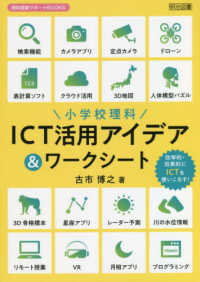- ホーム
- > 洋書
- > 英文書
- > Business / Economics
Full Description
Translating the latest research into practical applications and best practices, authors Christopher P. Neck, Jeffery D. Houghton and Emma Murray unpack how managers can develop their managerial skills to unleash the potential of their employees. The text examines how individual characteristics, group dynamics, and organizational factors affect performance, motivation, and job satisfaction, providing students with a holistic understanding of organizational behaviour. Packed with critical thinking opportunities, experiential exercises, and self-assessments, the new edition provides students with a fun, hands-on introduction.
Contents
Preface
Acknowledgments
About the Authors
PART I: INTRODUCTION
CHAPTER 1: WHY ORGANIZATIONAL BEHAVIOR MATTERS
What Is Organizational Behavior and Why Is It Important?
Managing Human Capital
Behavioral Science Disciplines That Contribute to OB
A Critical-Thinking Approach to OB
OB Challenges and Opportunities
Three Levels of Analysis in OB
Positive OB and High-Involvement Management
PART II: INDIVIDUAL PROCESSES
CHAPTER 2: DIVERSITY AND INDIVIDUAL DIFFERENCES
Diversity in OB
The Importance of Individual Differences
Nature versus Nurture
Myers-Briggs Type Indicator
The Big Five Model
Other Personality Attributes
CHAPTER 3: PERCEPTION AND LEARNING
Perception: Interpreting Our Environment
Common Perceptual Distortions
Common Attribution Errors
Learning Processes: Behavioral Theory
Learning Processes: The Cognitive View
CHAPTER 4: EMOTIONS, ATTITUDES, AND STRESS
Emotions in Organizational Behavior
Emotions in the Workplace
Attitudes and Behavior
Common Workplace Attitudes
Stress in the Workplace
Stress-Related Outcomes and Wellness
CHAPTER 5: MOTIVATION: CONCEPTS AND THEORETICAL PERSPECTIVES
The Motivation Process
Needs Theories
Goal-Setting Theory
Equity Theory
Expectancy Theory
CHAPTER 6: MOTIVATION: PRACTICES AND APPLICATIONS
Intrinsic Motivation
Types of Extrinsic Rewards
Motivation through Job Design
Psychological Empowerment
Nontraditional Work Schedules
PART III: TEAMS AND TEAMWORK
CHAPTER 7: TEAMS
The Difference between Teams and Groups
A Model of Team Effectiveness: Processes and Outcomes
Types of Teams
A Model of Team Effectiveness: Context and Composition
Team Decision Making
CHAPTER 8: DECISION MAKING, CREATIVITY, AND INNOVATION
Decision Making and Problem Solving
Decision Making in the Real World
Creativity and Innovation in Individuals, Teams, and Organizations
A Three-Component Model of Creativity
Creative Potential versus Practiced Creativity
The Innovation Process and Types of Innovation
Types of Innovation in Organizations
CHAPTER 9: ETHICS AND SOCIAL RESPONSIBILITY IN ORGANIZATIONS
Ethics in Organizations
Ethical Decision Making
Ethical Leadership and Followership
Social Responsibility
Building Ethical and Socially Responsible Organizations
CHAPTER 10: EFFECTIVE COMMUNICATION
The Role of Effective Communication in Influencing Others
Types of Communication Channels
Barriers to Communication
Communicating in Organizations
Cross-Cultural Communication
CHAPTER 11: TRUST, CONFLICT, AND NEGOTIATION
Trust in Organizations
Conflict in Teams and Organizations
Conflict Management Strategies
Negotiation and Dispute Resolution
Bargaining Approaches
PART IV: LEADERSHIP AND INFLUENCE PROCESSES
CHAPTER 12: LEADERSHIP PERSPECTIVES
What Is Leadership?
Formal and Informal Leadership
Basic Leadership Types
Early Leadership Perspectives
Contemporary Leadership Perspectives
Power-Distributing Leadership Perspectives
Values-Based Leadership Perspectives
Cross-Cultural Leadership
Leadership and Gender
CHAPTER 13: INFLUENCE, POWER, AND POLITICS
Power: Definition and Overview
Basic Sources of Power
Using Power: Tactics for Influencing Others
Consequences of Influence Tactics
Organizational Politics
Four Different Types of Organizational Politics
PART V: ORGANIZATIONAL CONTEXT
CHAPTER 14: ORGANIZATIONS AND CULTURE
What Is Organizational Culture?
Artifacts of Organizational Culture
Functions of Organizational Culture
Types of Organizational Cultures
Adapting Organizational Practices across Cultures
International Assignments and Career Development
Shaping Organizational Culture
CHAPTER 15: ORGANIZATIONAL CHANGE AND STRUCTURE
The Change Process
Forces for Change
Resistance to Change
Organizational Structure
Organizational Development
Glossary
Notes
Name Index
Subject Index








